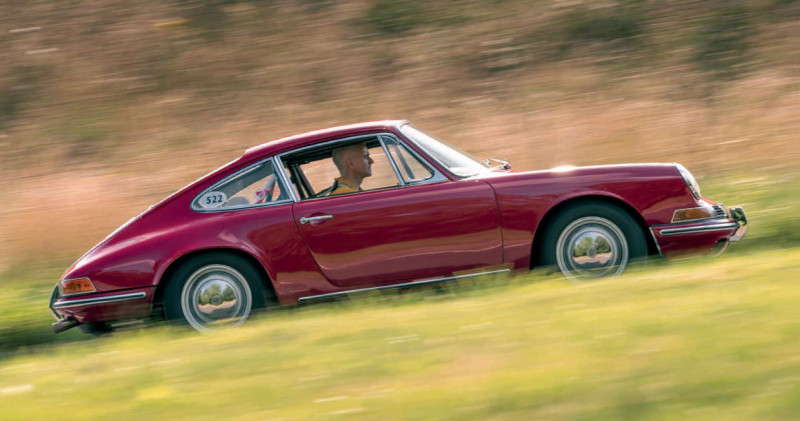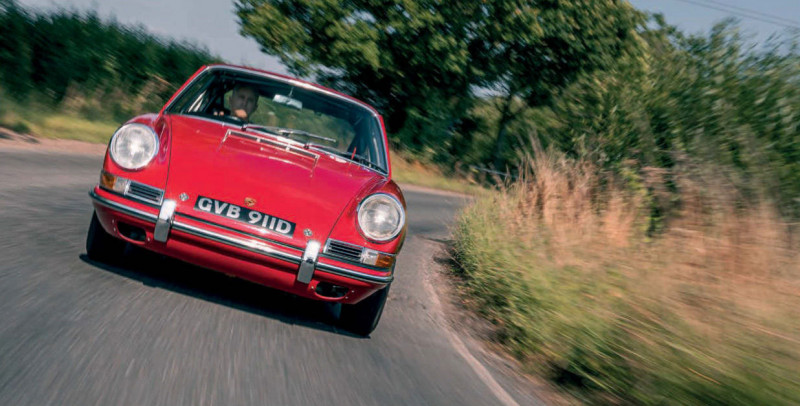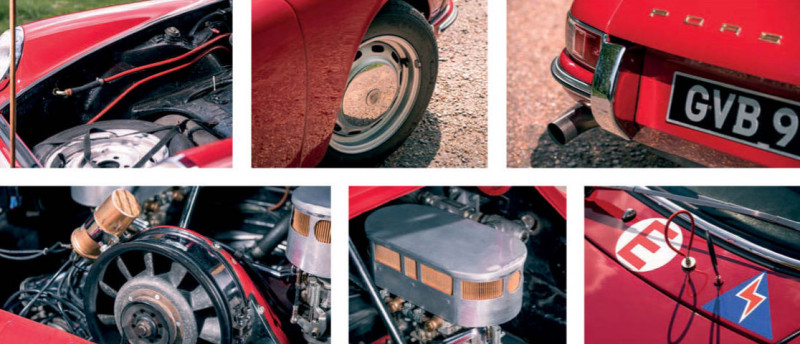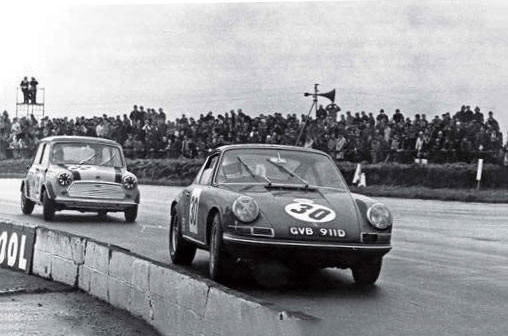1966 Porsche 911 2.0
Opening Porsche’s motorsport account in the UK and beyond, this surviving 1966 two-litre 911 landed in living rooms with a bang, crash and wallop, before its serious attack of asphalt propelled Vic Elford to international stardom… Words Dan Furr Photography Dan Sherwood.
AIR-COOLED SURVIVOR QUICK VIC ELFORD’S
WINNING 1966 911 FROM RALLY AND RACE VICTORIES TO THE ROAD IN THE RED
Ask a petrolhead to bring to mind the cars of rallycross and they’ll almost certainly conjure up images of the Austin Metro 6R4, Ford RS200, Audi Quattro S1, Citroen Xsara and maybe even a classic Mini mud machine. Air-cooled 911? Not so much, which is why it may come as a surprise to learn a two-litre 911 was campaigned by Vic Elford in the inaugural rallycross event at Lydden Hill on 4th February 1967.

Broadcast on British national television, the event was motorsport like no other, and though we’re familiar with the sight of 911s in various road, race and rally trim today, things were quite different in the mid-1960s.
Elford began his professional career as a co-driver, teaming up with BMC works pilot, David Seigle-Morris (best remembered for running the punishing Gulf London rally in the late 1960s) in a modified Triumph TR3A. Elford, however, harboured desire to become a first-rate driver in his own right, ambition leading to the purchase and preparation of a Mini for the 1961 rally season. Advancement through the ranks eluded him and, come season end, the Mini was sold, but determined to bounce back, the London lad jumped into the hot seat of a factory-backed Auto Union DKW Junior and began to enjoy success as the 1962 season wore on. Twelve months later, he was back in a Triumph, throwing a TR4 around in such convincing fashion Ford offered him a drive in a works Cortina. This invitation promised the backing of team who could guarantee mechanical reliability, something which had been lacking in all the cars Elford had driven thus far, despite his impressive performances and ever-quicker pace.

Ford and Elford enjoyed a successful three-year stint together, but at the close of the 1966 season, he needed a fresh challenge and a new car to compete in. He’d accepted an invitation to drive the relatively new 911 with fellow Brit, David Stone, serving as co-driver for November’s Tour de Corse, and after finishing third overall (pipped to the post by Rolland Jean and Augias Gabriel’s Alfa Romeo Giulia GTA, and event winners, Piot and Jacob-Jean Francois, in the Renault 8 Gordini), the pair achieved the same again in a 911 at the 1967 Monte Carlo Rally, held in January. Needless to say, when the invitation to participate in the following month’s made-for-television rallycross event came Elford’s way, it was the air-cooled, two-litre, German sports coupe he immediately thought of as perfect for the job. There was only problem: despite Elford’s recent podium finishes and obvious talent behind the wheel of the 911, factory motorsport director, Fritz Huschke von Hanstein, had no real interest in rallying Porsche’s flagship product, preferring to concentrate the works team’s efforts on circuit action. Besides, there were no 911s available in Stuttgart for Elford to make use of in February. “Speak to AFN. See if they can help,” came the instruction.
HIS FORMULA ONE DUTIES AND WIDER RESPONSIBILITIES TO PORSCHE WERE TAKING UP SO MUCH TIME, HE EXITED THE BRITISH SALOON CAR CHAMPIONSHIP
BIGGER THINGS
The first UK-sold Porsche was supplied to its proud purchaser in 1954 by Archibald Frazer Nash (AFN) from premises at Falcon Works, located on London Road in Isleworth, Middlesex. Two years later, AFN became the sole UK concessionaire for Porsche Cars until the formation of Porsche Cars Great Britain in 1965. By the time of Elford’s enquiry, AFN boss, John Aldington, was Porsche Cars Great Britain’s Managing Director, but even he was without any available 911s, a consequence of the model not being particularly well-known outside of Germany and UK stock levels kept correspondingly low. The only car Aldington could offer was AFN’s own demonstrator, one of the earliest right-hand drive 911s. In standard street specification, the red two-litre Porsche wasn’t the ideal solution, but it was the only one at Elford’s disposal. At least, Aldington argued, Elford could hit Lydden in a 911, even if was pitched against motorsport metal specially prepared for the event. Besides, there would be valuable television coverage for Porsche, Elford and AFN to come from the arrangement.

‘Grudge match’ is the best way to describe what followed. Elford’s former Ford teammates — including Roger Clark and Brian Melia in Cortinas — were determined to beat him, immediately turning rallycross into a heavy contact sport. Aldington must have spat coffee all over his tellybox when he saw GVB 911D being smashed to pieces live on ITV. Whether he ejected caffeine from his nostrils or not, he was so incensed by what he was witnessing, he immediately telephoned Elford’s wife, demanding to know why AFN’s valuable Porsche was being totalled in full view of the entire nation. By event end, not a single panel was straight, the 911’s windscreen was cracked and its lights were missing in action, yet despite the rear-engined tin-top’s road car specification, it reigned supreme on the mixed-surface circuit — Elford had done the unthinkable and won, albeit by the narrowest of margins.
Fellow rallycross competitor and classic Mini driver, Roy Edwards, offered use of his trailer to enable Elford to carry the battered 911 back to Aldington. To Edwards’ amazement, Elford declined the offer, instead kicking the windscreen free, donning goggles and driving home, where an infuriated Mrs Elford recounted tales of an angry Aldington quizzing her down the ‘phone. Understandably, her betrothed felt more than a little sheepish when he returned the battle-scarred 911 to AFN the following morning. He needn’t have worried. Aldington’s fury had already turned to joy by the time man and machine arrived at AFN’s headquarters — the company’s phones had been tied up with a high number of enquiries from prospective Porsche purchasers impressed by what they’d seen on TV. The win on Sunday, sell on Monday motto was ringing undeniably true.
GVB was shipped back to Stuttgart for repair. Huschke von Hanstein, alerted to Elford’s winning ways, asked him what he wanted to do next. His ambition had, in fact, been circuit racing, but working with a modest budget, rallying was all he’d been able to afford. Rallycross, however, had proved Elford to be quicker on asphalt than mud, which is why Porsche agreed to hand the car back for participation in the British Saloon Car Championship, a competition the 911 was eligible for due to its 2+2 cabin layout. GVB would be far from the same-spec road dweller it once was, though — by the close of March 1967, the car was kitted out with a 906-derived two-litre flat-six in more or less Le Mans specification, including titanium connecting rods, lightweight cam drive, Weber carburettors (in place of the standard Solex units) and many prototype parts besides. Entered into the competition’s two-litre class under the AFN banner, Elford scored a third-place finish at both Brands Hatch outings, a second-place finish at Silverstone and other impressive placings contributing to the two-litre class win. It’s worth noting his on-track rivals included Graham Hill, Jackie Oliver, Tony Lanfranchi, John Fitzpatrick and championship winner, Frank Gardner.

By now, Aldington was full of enthusiasm for ‘Quick Vic’ and how he could make the 911 sing. Stuttgart, too, was impressed, giving Elford a left-hand drive 911 to contest the 1967 European Rally Championship, which he won. He was also given a drive in the 906 alongside Dutchman, Ben Pon, for the 1967 24 Hours of Le Mans. It was a dream come true and one Elford paid back to Porsche in the form of a class win, finishing seventh overall after completing 327 laps. This was clearly one of the most versatile drivers in the business, and though further outings at Sarthe followed (notably a string of drives in partnership with Richard Attwood, Gerard Larrousse, Kurt Ahrens Jr and Gerhard Mitter, with cars including the 908 and 917 between 1968 and 1971, before a switch to Alfa Romeo’s competition department, Autodelta, and scoring another first-in-class with a Ferrari 365 GTB/4 for Charles Pozzi’s team in 1973), not to mention a career in F1 (driving Coopers, a McLaren and a BRM P160), all eyes were on what Elford could do with the 911 in 1968.
SMOKE AND MIRRORS
Porsche and AFN were keen for spectators to think the Stuttgart concern was fielding a new car, which is why GVB was stickered with a fictitious registration number: BEM 911F. The B referenced chief sponsor, Bill Bradley, the E stood for Elford, while M paid tribute to race engineer, Christopher Maltin. This was, though, every bit GVB, and the car was promptly entered into the two-litre class of the 1968 British Saloon Car Championship to pick up where it left off. Preparation for the 500km of Snetterton (the final round of the European Touring Car Challenge) also occurred, work seeing a long-range fuel tank, lightweight polycarbonate windows, wider wheels and fatter tyres fitted to the car, but a regrettable DNF due to a loose camshaft and a ruptured oil pipe meant Elford’s racing glory would need to be earned elsewhere. It didn’t take long for him to find it, winning the 1968 24 Hours of Daytona in a 907 shared with Jo Siffert, Hans Herrmann, Rolf Stommelen and Jochen Neerpash (Porsche’s first overall win in a daylong endurance race), bagging top honours at the year’s Monte Carlo Rally in a 911 T with his old chum, David Stone, and winning the Targa Florio with Umberto Maglioli in a 907, despite losing eighteen minutes due to a burst tyre on the first lap.
Obviously, GVB played a huge part in helping Elford progress his motorsport career, but all things must pass, and so it was with his time in charge of the red road and rally rocket. Indeed, by easter 1968, his F1 duties and wider responsibilities to Porsche’s global motorsport programme were taking up so much of his time, he exited the British Saloon Car Championship, but not before winning the two-litre class in rounds of the competition at Brands Hatch and Silverstone. Subsequently, GVB’s original registration number returned to the car and it was offered for sale through AFN. Enter Nick Faure. A Porsche devotee who achieved fame through racing and selling 356s in the 1960s, he would go on to compete at Le Mans eleven times between 1975 and 1985, racing the 911 Carrera RSR alongside John Cooper, as well as strutting his stuff for Kremer Racing in the 935 K2 with John Fitzpatrick as co-driver. Before all this, however, seeing how competitive GVB was, and identifying the 911’s huge potential to enable him to eclipse his achievements with the 356 in motorsport, Faure cobought a stake in the car (retaining its 906-sourced beating heart) and, sponsored by Demetriou Group, entered the two-litre air-cooled track attacker into various races at the back end of 1968, before competing in the bulk of the 1969 British Saloon Car Championship.
Faure finished fourth in three British Saloon Car Championship races: Silverstone, Snetterton and at the televised round at Crystal Palace. A sixteenth-place overall finish in championship standings meant he was fourth-in-class at season end. Impressively, his lap times were even quicker than Elford’s. It was a similar story for the next few years — Aldington was so dazzled, he offered Faure a seat as an AFN driver in a 911 Carrera RS 2.7 Lightweight for the 1973 British Production Sports Car Championship, before the team switched him to the duck-tailed model’s three-litre successor in 1974. He also drove an RSR for Ecurie Francorchamps at the 1974 1,000km of Brands Hatch, leading to the first of his Le Man outings with the RSR a year later (a performance ending with sixth place overall and second-in-class). Once again, GVB had acted as stepping stone for a promising young driver to advance their racing career. Faure didn’t only use GVB to get him around a track quickly, though.
To support his time in motorsport, he was working as a freelance illustrator on Fleet Street. Regularly, he’d hop into GVB — which remained road legal, despite its motorsport activities and blaring megaphone exhausts — and floor it all the way across London in the middle of the night to hand his work to editors working on pressing publishing deadlines.
During Faure's time with GVB, its original oil tank was modified and relocated to sit in front of the rear wheel, rather than behind it. AFN spanner man, Maltin, reasoned this would help the 91Vs front-to- back weight distribution, thereby improving handling. It worked, but with Faure setting his sights on more powerful Porsches at the start of the 1970s, and with increasingly more competitive cars taking the fight to the 911 in the British Saloon Car Championship, GVB was once again put up for sale through AFN. The buyer was Christian Favre, ninth generation of the famous Favre family of Swiss watchmakers, who took ownership in January 1970, but little is known of the car’s activities during the course of the following two years, save for a catastrophic engine bay fire. The cost of rebuilding the 906-specification two-litre flat-six proved prohibitively expensive for Favre, who chose to box all of the unit’s component parts and store them with what had become little more than a rolling shell in a friend’s garage, but by 1972, he was being asked to re-home his part-dismantled Porsche, which is why it passed into the hands of sports car enthusiast, Roger Connell.
HISTORY LESSON
Connell bought GVB as a restoration project (before Porsche restoration was fashionable!) unaware of the air-cooled Porsche’s illustrious — and at the time, still recent — history, which Favre did little to highlight. It took Connell until 1980 to resurrect the car, grabbing weekends and evenings as and when motivation to work on the project engaged him, but, in truth, this extended period of dry storage and retirement from racing is likely what saved the poorly Porsche from being cut, shut and crashed as a race car at a time early two-litre 911s weren’t worth a huge sum of money. Even so, he commissioned a rebuild of the 906 lump to original specification, resulting in a competitive 911 more or less in the same condition as when Faure last sat behind the wheel. Unfortunately, while dormant, the oil cooler lines had calcified spent lubricant. On the first, highly anticipated turn of the key, the open thermostat allowed dirt to be spat into the engine, immediately hammering the bottom end and causing sudden failure. It was a heart-breaking moment for Connell, but he had the good sense to keep hold of the busted boxer when a standard two-litre flat-six was sourced and the car was rebuilt as close to AFN-fresh road car standard as he could achieve.
In 1982, somewhat disillusioned with the way his time with GVB had panned out, Connell accepted an offer for the car from Peter Russell, who many will know as a key player in establishing today’s classic rally movement. His son, Rob, the car’s current custodian, picks up the story. “I was born in 1973,” he reveals. “As a child, I remember my father saying he’d always wanted an early 911, and shortly before my ninth birthday, he bought GVB. He loved the lack of whale tail and impact bumpers of the original 911 design and, as someone active in the rallying scene, reasoned GVB would be an excellent choice for tarmac rally stages.” Rob remembers the day the car joined the Russell household. “My brother and I were hanging off the roll cage,” he laughs. “Dad dropped the windows and booted it through the Dartford Tunnel. The noise was exhilarating!”
TRIUMPH OVER ADVERSITY
Russell the Elder — a seasoned rally man who’d competed in the London- Sahara-Munich World Cup Rally in a Triumph Dolomite Sprint, often cited as the world’s first mass-produced multivalve car — would use GVB to compete in the 1983 Coronation Rally (hosted in Wales and regarded as the first proper historic rally), winning the two-litre class. Further class wins followed, and it came as little surprise when Rob and his brother were also bitten by the bug. “We’d enjoyed family holidays to Ireland in the 911, but by the late 1980s and into the early 1990s, it was almost exclusively being used for participation in historic rallies. My brother and I would attend these events and, somewhat predictably, I became Dad’s co-driver.
During this time, the replacement engine let go when a cam follower decided to give up the ghost. A protracted period of flat-six restoration took place thereafter, with classic Porsche rally specialist, Frances Tuthill, given the broken flat-six and the boxes of 906 parts handed to us by Roger Connell.” The engine which was returned to the Russell clan made use of the standard crankcase, but was equipped with the 906 cams, Weber 45 carbs (recommended by Tuthill for increased drivability when compared to the more aggressive 48s fitted in period) and titanium rods. Meticulously serviced ever since, it provides GVB with a solid, dyno-verified 178bhp. Time had, of course, taken its toll on this well-weathered 911 in other ways. A small patch of fresh metal in front of the fuel cell (the same enlarged-capacity tank fitted back in the day), for example, was welded into place, and in response to the original red paintwork starting to peel, the car was treated to a full respray. By now, Rob was rallying as the number one driver, first in a classic Mini, then a Nissan Micra and, later, in various Peugeots with Peter navigating. The 911 remained largely unused during this time, father keen to help son spread his motorsport wings (“until my girlfriend became co-driver!”). Sadly, the 911 would remain dormant for some time to come — in 2000, Peter passed away.
“I learned a lot from my father,” Rob tells us. “As is the case with many involved in the rally scene, I take care of most mechanical work and maintenance myself, just like Dad did. As a family, this approach is the only way we could afford to do compete.” Family would also contribute to the car’s next phase of limited activity — Rob’s first daughter was born in 2002, and for the following three years, save for the occasional sprint, GVB was kept in a state of suspended animation. With the emergence and popularity of classic motoring events, including the Goodwood Revival, however, a desire to show GVB to an audience who would appreciate its historical significance as one of the first 911s to achieve serious competition success led to recommissioning in 2010. The dampers were sent to Koni for a full rebuild and the remaining suspension was overhauled. The alternator was refurbished and the carburettors were also given a new lease of life. Andy Prill, head of Prill Porsche Classics, provided Rob with invaluable advice along the way, but even this celebrated marque expert was unable to explain the presence of Jaguar calipers. “Nobody seems to know where they came from,” Rob laughs. “I suspect they were fitted before Roger bought the car, but with no old photographs showing this 911 with its wheels off, it’s almost impossible to prove. Because of this, I was unable to get FIA papers allowing me to race at Goodwood, which is why I fitted standard 911 anchors until further evidence showing the clear appointment of Big Cat brakes in period materialises.”
SWINGING SIXTIES
Rob went on to enter GVB into the Historic Sports Car Club’s ‘60s Roadsports races at Brands Hatch and Oulton Park for two years running, with third-in-class at the Brands Hatch Superprix and success competing in the Aldington Trophy (named after AFN’s founder and open to pre-1967 two-litre 911s) rewarding his efforts, but with no clear route to generating an invite to Goodwood for either Revival or Festival of Speed exhibition purposes, sporadic use on street and circuit followed. “I drove the 911 to my brother’s wedding in the south of France, a week in the Pyrenees and to various Porsche Club Motorsport track days, but my focus with this car was firmly on securing an invite to Goodwood. I simply wasn’t sure how to go about getting one,” he shrugs. Two key anniversaries provided the solution. The first was a celebration of the fiftieth anniversary of rallycross in 2017, when historic rallycross cars were brought out of retirement for a special Festival of Speed display organised by Retro Rallycross, while the second was the opportunity to drive the length of Goodwood’s famous hillclimb as part of Porsche’s seventieth anniversary celebrations at Festival of Speed in 2018. Mission accomplished, with various track days (pleasingly, some at Goodwood) enjoyed since. “I’d love to compete in this car again,” he confirms. “HSCC events are great. The drivers are very respectful of each other, as well as the value of participating cars. GVB has only covered 48k miles from new, so there’s plenty of life left in this little Porsche yet. I don’t have absolute plans, but Dad bought this 911 to be used for high days, holidays and rallying, and I’m determined to carry on in the same spirit. Of course, I’m aware of the car’s financial value in the current climate, and I’d certainly hate to prang it, but I’ll continue to use this aircooled classic long into the future.”
This is music to our ears, though we’ll wager it’s safe to work on the assumption he’s likely to be a tad more considerate than Quick Vic was when this radiant red 911 burst onto television screens fifty-four years ago. Just steer clear of Cortinas, Rob!

Above With star turns at Goodwood under its belt, we’re looking forward to seeing what the future holds for this fantastic 911. Below Rob recalls swinging from the roll cage the day his father bought GVB. Above Elford in 1967, competing with GVB in the two-litre class of the British Saloon Car Championship at Silverstone Circuit. Below A mix of 906 and standard two-litre parts went into the Tuthill-built flat-six currently powering the classic 911. Above We’re thrilled Rob uses the car as intended, rather than it end up tucked away, out of sight in a private collection. Above It’s amazing to think this unassuming air-cooled classic is one of the most historically significant surviving 911s
ONCE AGAIN, GVB HAD ACTED AS STEPPING STONE FOR A PROMISING YOUNG DRIVER TO ADVANCE THEIR RACING CAREER


